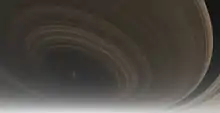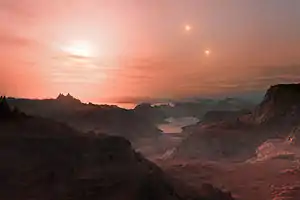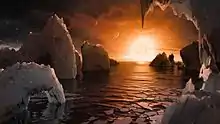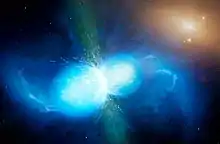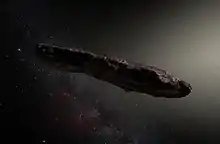2012 TC4
2012 TC4 is a tumbling micro-asteroid classified as a bright near-Earth object of the Apollo group, approximately 10 meters (30 feet) in diameter.[6][7][8] It was first observed by Pan-STARRS at Haleakala Observatory on the Hawaiian island of Maui, in the United States. As of 1 October 2017, it had a small Earth minimum orbital intersection distance of 0.000149 AU (22,300 km).[2] On 12 October 2017, it passed Earth at 0.00033524 AU (50,151 km).[2]
 Radar movie of 2012 TC4[1] | |
| Discovery [2][3] | |
|---|---|
| Discovered by | Pan-STARRS 1 |
| Discovery site | Haleakala Obs. |
| Discovery date | 4 October 2012 |
| Designations | |
| 2012 TC4 | |
| Orbital characteristics [2] | |
| Epoch 1 October 2017 (JD 2458027.5) | |
| Uncertainty parameter 1 | |
| Observation arc | 5.19 yr (1,897 d) |
| Aphelion | 1.8786 AU |
| Perihelion | 0.9335 AU |
| 1.4061 AU | |
| Eccentricity | 0.3361 |
| 1.67 yr (609 d) | |
| 332.79° | |
| 0° 35m 27.96s / day | |
| Inclination | 0.8572° |
| 198.23° | |
| 222.58° | |
| Earth MOID | 0.000149 AU (0.0580 LD) |
| Mars MOID | 0.03 AU[4] |
| Physical characteristics | |
| Dimensions | 15 m × 8 m[5][6] |
Mean diameter | 7–13 m[7][8] 15 m[8] |
| |
| 12.9–31[10] | |
Approaches to large bodies
| Date (UT) | Object | distance in km (center–center) |
3-Σ uncertainty in km |
Speed- relative in km/s |
|---|---|---|---|---|
| 13 October 1996 | Earth | 753 000 | ± 7000 | 6.445 |
| 13 October 1996 | Moon | 530 000 | ± 6300 | 7.144 |
| 3 March 1997 | Earth | 46 928 000 | ± 5400 | 4.190 |
| 2 August 2009 | Earth | 68 969 000 | ± 510 | 7.039 |
| 12 February 2010 | Earth | 40 183 000 | ± 1200 | 14.640 |
| 24 January 2011 | Mars | 12 875 000 | ± 210 | 5.957 |
| 12 October 2012 | Earth | 94 965 | ± 0.32 | 7.123 |
| 12 October 2012 | Moon | 113 886 | ± 0.64 | 6.773 |
| 12 October 2017 – 05:42 | Earth | 50 151 | ± 0.14 | 7.647 |
| 12 October 2017 – 19:19 | Moon | 277 697 | ± 0.34 | 6.101 |
| 28 August 2019 | Earth | 68 910 000 | ± 810 | 2.807 |
| 29 December 2019 | Earth | 34 467 000 | ± 1100 | 13.817 |
| 30 September 2034 | Mars | 7 481 000 | ± 3500 | 9.980 |
| 5 September 2048 | Earth | 51 740 000 | ± 15000 | 6.166 |
| 29 July 2050 | Mars | 9 227 000 | ± 11000 | 9.980 |
| 19 October 2050 | Moon | 1 402 000 | ± 7900 | 7.146 |
| 19 October 2050 | Earth | 1 792 000 | ± 7500 | 6.164 |
| 2 January 2053 | Earth | 47 270 000 | ± 44000 | 16.447 |
| 13 February 2076 | Mars | 6 260 000 | ± 140000 | 9.723 |
| 7 September 2077 | Earth | 47 690 000 | ± 730000 | 16.458 |
| 21 November 2079 | Earth | 2 478 000 | ± 300000 | 6.031 |
Data from JPL 60 solution date 3 November 2017[11]
2012 Earth encounter
.jpg.webp)
2012 TC4 was discovered on 4 October 2012 at apparent i-band magnitude 20.1 while the asteroid was 0.03 AU (4,500,000 km; 2,800,000 mi) from Earth.[3] It came within 0.000634 AU (0.247 LD, 94,800 km, 58,900 mi) from Earth on 12 October 2012.[11]
During the 2012 close approach, the asteroid only had an observation arc of 7 days, between 4 and 11 October 2012, so the exact distance of the 2017 closest approach was poorly constrained. With the 7 day observation arc, the asteroid had a 3-sigma chance of passing between 0.00008818 and 0.002896 AU (0.034 to 1.127 LD, 13,200–433,200 km, 8,200–269,200 mi) from Earth on 12 October 2017.[13] Astronomers were certain that it would not pass closer than 6,800 km from the surface of Earth, ruling out any possibility that it could hit the Earth in 2017.[14]
2017 Earth encounter



On 12 October 2017 at 5:42 UT, the asteroid passed 0.00033524 AU (50,151 km; 31,163 mi) from Earth.[11] Observations between July and October reduced the uncertainty region from several hundred thousand kilometers[13] to about ±140 meters.[15][2] The asteroid was removed from the Sentry Risk Table on 16 October 2017 using JPL solution #56.[16] Prior to the encounter, it was rated −4.11 on the Palermo scale, with a 1 in 1,000 chance of impact over the next hundred years.[17]
Paul Chodas of NASA's Center for near-Earth Object Studies, and Vishnu Reddy of the University of Arizona's Lunar and Planetary Laboratory, viewed the 2017 flyby (inside of the orbit of the Moon) as a way to test and refine the global asteroid detection and tracking network designed to give warning of objects heading toward Earth.[14] Reddy coordinated the effort, involving over a dozen institutions worldwide.[14][18][19] In addition to the observation campaign, NASA used this exercise to test communications between the many observers and also to test internal U.S. government messaging and communications up through the executive branch and across government agencies, as it would during an actual predicted impact emergency. Results of the campaign were published on 3 November 2017.[5]
The asteroid remained too faint to be recovered with automated astronomical surveys until early September,[20] but a more targeted observation with the Very Large Telescope recovered it on 27 July 2017 at apparent magnitude 26.8, while the asteroid was 0.4 AU (60,000,000 km; 37,000,000 mi) from Earth, making it one of the dimmest asteroid recoveries ever. As such, 2012 TC4 has become the first known asteroid ever to be observed passing less than 1 Lunar distance from Earth twice in a row.[21] At the time of recovery the asteroid was about 100 million times fainter than what can be seen with the naked eye[22] and 500 times fainter than when it was discovered in 2012. As a result of the 2017 recovery observations, it was known that on 12 October 2017 at 5:42 UT, the asteroid would pass 0.0003352 AU (50,150 km; 31,160 mi) from Earth.[11] Then at 19:19 UT, the asteroid would pass 0.001856 AU (277,700 km; 172,500 mi) from the Moon.[11] 2012 TC4 peaked at about apparent magnitude 12.9,[23] and was too faint to be seen without a telescope. The Earth approach of 2017 increased the asteroid's orbital period from 1.67 years to 2.06 years.[24]
2012 TC4 reached a maximum apparent magnitude of 12.9 just prior to its closest approach, soon after which it came too close to the Sun to be seen with telescopes.[23] It was last seen from Mauna Kea Observatories on 21 October 2017 at an apparent magnitude of 24,[4] when the asteroid was 57° from the Sun.[10]
Physical properties
 size reference of 2012 TC4, based on radar observations. |
Fast rotator and tumbler
Studies of the asteroid's light curve in October 2012, found it to have a rotation period of 0.2038 hours (or 12 minutes and 14 seconds) with a brightness variation of 0.93 magnitude (U=3-), which is indicative for a non-spherical shape.[9][lower-alpha 1] 2012 TC4 is a fast rotator, which is rather typical for its small size. The fastest rotator currently known is 2014 RC, a similarly sized NEO, with a period of only 16 seconds. Lightcurves obtained during the 2017 encounter confirmed that 2012 TC4 is in a non-principal axis rotation, commonly known as tumbling.[7][5] The spin axis varies on timescales of minutes, with a second period of 0.142 hours (or 8.5 minutes).[8] The lightcurve amplitude suggests a ratio of largest to smallest axis of at least 2.3.[7]
Radar observations
Radar images were taken from Goldstone Observatory and Green Bank Telescope on 12 October 2017. The delay-doppler images had a range resolution of 1.9 meters/pixel, the highest resolution ever obtained using Goldstone transmissions.[6][1] The images showed that 2012 TC4 was a very elongated object about 50 feet (15 meters) long and roughly 25 feet (8 meters) wide.[5] The high circular polarization ratio found for 2012 TC4 is consistent with results seen from E- and V-type NEAs previously.[6] Observations from Arecibo Observatory were planned, but had to be cancelled due to damage to the observatory as a result of Hurricane Maria.[25]
Composition
The spectrum of 2012 TC4 is that of an E- or Xe-type asteroid.[7][6] E-type asteroids tend to have a high albedo (>0.30). This agrees with the albedo of 0.35 found for 2012 TC4.[1] This type of asteroids is commonly found in the inner Main Belt.[26]
2012 TC4 is composed of igneous material.[5] The short rotation period of 2012 TC4 implies that it is not a rubble pile but rather a monolithic object of non-negligible strength, which is typical for very small asteroids.[7]
Orbit change
As a result of 2012 TC4's frequent approaches to Earth, its orbit changes significantly over short periods of only decades. Its two observed close approaches and their effects are shown below:
| Date | Event | Semimajor axis (AU) | Perihelion (AU) | Aphelion (AU) | Eccentricity | Inclination (°) | Argument of perihelion (°) | Ascending node (°) |
|---|---|---|---|---|---|---|---|---|
| 2012-10-01 | pre-2012 approach | 1.2744 | 0.9015 | 1.6472 | 0.2926 | 1.4097 | 234.7282 | 198.5560 |
| 2012-10-12 | 2012 approach | 1.3837 | 0.9115 | 1.8559 | 0.3413 | 1.2320 | 228.5354 | 198.4622 |
| 2012-10-30 | post-2012 approach | 1.3893 | 0.9305 | 1.8480 | 0.3302 | 0.8582 | 223.1271 | 198.1033 |
| 2017-10-01 | pre-2017 approach | 1.4155 | 0.9410 | 1.8901 | 0.3353 | 0.8566 | 221.8553 | 198.0054 |
| 2017-10-12 | 2017 approach | 1.7076 | 0.9522 | 2.4630 | 0.4424 | 0.1693 | 218.4570 | 193.6520 |
| 2017-10-30 | post-2017 approach | 1.6492 | 0.9711 | 2.3273 | 0.4112 | 0.5327 | 248.6359 | 208.5051 |
| 2050-01-01 | pre-2050 approach | 1.6226 | 0.9688 | 2.2765 | 0.4030 | 0.5266 | 266.6192 | 197.8009 |
Between 2012 and 2017, 2012 TC4's average distance from the sun increased by almost 0.4 AU, with the time it takes to orbit the sun increasing by 250 days. Its closest approach to the Sun also increased significantly, from 90% of the Earth's distance to the Sun to 97%, and its inclination lowered slightly, going from 1.4 degrees to less than 0.5 degrees relative to Earth's orbit.
As a result of non-gravitational forces such as the Yarkovsky effect on small bodies, it is difficult to constrain its orbit more than a few decades into the past or future.
See also
Notes
- Lightcurve plot of 2012 TC4 at the Palmer Divide Observatory by Brian D. Warner (2012). Rotation period 0.2038±0.0002 hours with a brightness amplitude of 0.93±0.05 mag. Summary figures for 2012 TC4 at the LCDB
References
- "The 2012 TC4 Observing Campaign -- Radar animations". University of Maryland. Archived from the original on 7 November 2017. Retrieved 2 November 2017.
- "JPL Small-Body Database Browser: (2012 TC4)" (2017-10-13 last obs.). Jet Propulsion Laboratory. Retrieved 17 October 2017.
- "MPEC 2012-T18 : 2012 TC4". IAU Minor Planet Center. 7 October 2012. Retrieved 14 March 2017. (K12T04C)
- "2012 TC4". Minor Planet Center. Retrieved 4 November 2017.
- "Astronomers Complete First International Asteroid Tracking Exercise". JPL. 3 November 2017. Retrieved 3 November 2017.
- "The 2012 TC4 Observing Campaign – Radar observations UPDATE October 12, 2017". University of Maryland. Retrieved 2 November 2017.
- Ryan, William H.; Ryan, Eileen V. (2017). "Physical Characterization of NEA 2012 TC4" (PDF) (PDF). University of Maryland. Retrieved 8 March 2018.
- "NEA 2012 TC4 -- Physical Properties". University of Maryland. Retrieved 2 November 2017.
- "LCDB Data for 2012 TC4". Asteroid Lightcurve Database (LCDB). Retrieved 28 September 2017.
- "NEODyS-2 2012TC4". Department of Mathematics, University of Pisa, Italy. Retrieved 4 November 2017.
- "Close Approach table for 2012 TC4". JPL. NASA. Retrieved 3 November 2017.
- "A Very Close Encounter". www.eso.org. Retrieved 11 August 2017.
- "Close Approach table for 2012 TC4 (using 7 day obs arc)". JPL. NASA. Archived from the original on 3 April 2013. Retrieved 22 October 2014.
- "Asteroid Flyby Will Benefit NASA Detection and Tracking Network". JPL. NASA. 28 July 2017. Retrieved 8 March 2018.
- "TC4: HOW NASA PLANS TO TEST ITS PLANETARY DEFENSE SYSTEMS ON CLOSE-APPROACH ASTEROID". Retrieved 7 October 2017.
- "Date/Time Removed". NASA/JPL Near-Earth Object Program Office. Archived from the original on 17 October 2017. Retrieved 17 October 2017.
- "Earth Impact Risk Summary: 2012 TC4". NASA/JPL Near-Earth Object Program Office. Archived from the original on 24 November 2012. Retrieved 13 March 2017.
- Coleman, Nancy (1 August 2017). "NASA's planetary defense system will be put to the test in October". CNN. Retrieved 2 August 2017.
- "The 2012 TC4 Observing Campaign". University of Maryland. Retrieved 2 November 2017.
- "NEODyS-2 Possible recovery list". Department of Mathematics, University of Pisa, Italy. Archived from the original on 14 March 2017. Retrieved 14 March 2017.
- "MPEC 2017-P26 : 2012 TC4". IAU Minor Planet Center. 6 August 2017. Retrieved 6 August 2017. (K12T04C)
- Math:
- "2012TC4 Ephemerides for 12 October 2017". NEODyS (Near Earth Objects – Dynamic Site). Retrieved 7 August 2017.
- "Orbit of NEA 2012 TC4". University of Maryland. Retrieved 11 October 2017.
- "Goldstone Radar Observations Planning: 2012 TC4". JPL. Retrieved 2 November 2017.
- Fornasier, S.; Clark, B. E.; Dotto, E. (July 2011). "Spectroscopic survey of X-type asteroids". Icarus. 214 (1): 131–146. arXiv:1105.3380. Bibcode:2011Icar..214..131F. doi:10.1016/j.icarus.2011.04.022.
External links
- Interesting Asteroids Past Earth Close encounters — Sormano Astronomical Observatory
- Image and animation of 2012 TC4 – Virtual Telescope Project
- Asteroid 2012 TC4 On Track For Close Earth Flyby AstroBob 10/3/17
- Asteroid 2012 TC4: House-Sized Asteroid Almost Hits Earth (PHOTO, VIDEO) 13 October 2012
- 2012 TC4 orbit and observations, Minor Planet Center
- 2012 TC4 at NeoDyS-2, Near Earth Objects—Dynamic Site
- Ephemeris · Obs prediction · Orbital info · MOID · Proper elements · Obs info · Close · Physical info · NEOCC
- 2012 TC4 at ESA–space situational awareness
- 2012 TC4 at the JPL Small-Body Database

